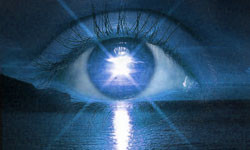I’ve written before about how you need to pay attention to each spot you look at so that your mind is fully engaged in seeing details. Here’s another way of thinking about how and why you need to look at things in this way.
Each small object or small area you look at should be the most important thing in the world to you. The only important thing in the world. For the moment you forget about other nearby objects you just looked at. When you’re stopped at a stoplight, for example, you forget for a few seconds about the stoplight, but you keep glancing back at it periodically to see if it has turned green. If you look at something else while in the same instant trying to remain aware of when the light turns green, you aren’t paying enough attention to what you’re looking at. Practice looking at a spot for a few seconds at a time, trying to focus all your mental resources on the spot by the force of your will.
You aren’t tensing your eyes when working on focusing your mind in this way. You aren’t trying to narrow your visual field down to the size of the spot you’re looking at. You’re trying to focus as much of your attention as possible on the spot, despite the fact that your visual field remains the same size and you aren’t really doing anything with your eyes. It’s an exercise in ignoring what you aren’t looking at. Your eyes are doing exactly what they need to do while you work with your mind.
Change the spot every few seconds. It doesn’t matter how blurry it is. Pick spots as small as you can, but large enough for you to see something, even if it’s a mess of blur. Keep blinking, and let your eyes remain loose.
I feel that at first it’s best to focus primarily on white or light colors and only secondarily on darker colors. Don’t try to look directly at black unless you think there’s another color within it. On an eye chart, for example, look at the white on the edges and insides of the black letters. Black is not a color. It’s an absence of reflected light rays, and it isn’t stimulating to the eyes.
If you practice this enough, you should find that it becomes easier to devote your attention to a spot without taking a few seconds before you are able to stop caring about surrounding objects, and you may feel the need to move to another spot sooner than a few seconds instead of staying on one spot for so long. The next spot can be close to the last point or far away. Closer is easier.
You should also find that you see a little better and your’e able to work with smaller spots, which means the distance between the spots can be shorter if you desire.
What you’re doing is adjusting your mind’s density of attention to fit the pattern it was designed to have, with a high concentration of data in the center and a decreasing concentration outside of the center, which in a simplistic sense is the way the retinal cells of your eyes are also arranged. I can’t find a good picture at the moment to illustrate this. But the system can only work in harmony when these elements match. The system has to treat peripheral data differently than central data, and to do that, the system requires that you mentally treat it that way. There has to be no contradiction. When there’s harmony, your eyes participate in a process where they are able to focus correctly and move easily and quickly the way they’re supposed to.
So to sum up, keep reminding yourself of three things as you work on this:
- Keep your eyes loose
- Look at white and other colors
- The one spot you’re looking at is the most important thing in the world
As I think about and try to explain these things or guess at what’s going on, I’m going to start doing so in a more positive way. It’s counter-productive to point out all the possible mistakes you could make, or to tell you what not to do. That just gets you focusing on what you don’t want. It’s better if you understand enough about what you need to be doing that you can decide for yourself whether something you’re doing is helpful in reaching your goals.
get help on our Facebook Group!

I founded iblindness.org in 2002 as I began reading books on the Bates Method and became interested in vision improvement. I believe that everyone who is motivated can identify the roots of their vision problems and apply behavioral changes to solve them.
